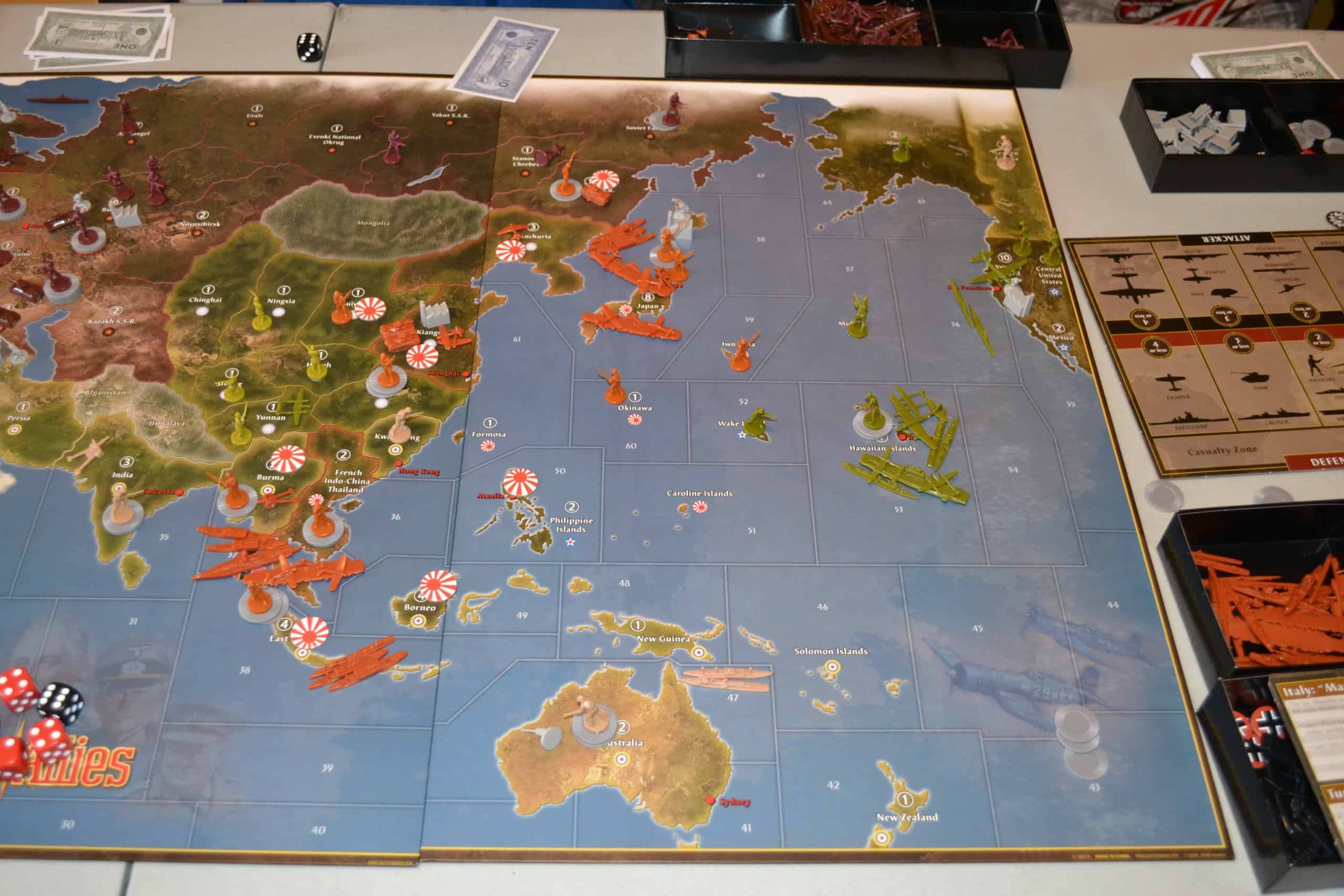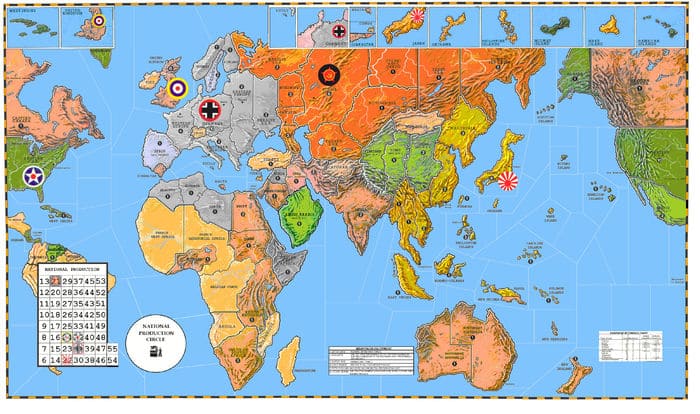Would you like to play a game? The original War Games movie was scary (yet great), but this article is about the history of wargaming throughout the years. We go all the way back to 1911. Shall we begin?
War can be a fascinating topic. When you step away from the gore and the tremendous loss of life, you get a fairly clear picture of two sides working at odds with one another. Armchair generals the world over can grasp the concepts involved even if they’ve never set foot on a battlefield.
Tabletop Wargaming
War translates strangely well into the world of board games. If you take a large enough view of things, armies can easily be seen as pieces on a giant board. Given that humans are already predisposed to boiling down massive concepts like war into simple games, it should come as no surprise that the war games are incredibly popular among the table top set.
War-based board games are usually games of grand strategy. One does not just manage armies in most cases – he or she manages nations. Success is determined not only by the dice, but by how a player manages all of his or her resources. These games represent war on the grandest scale.
Diplomacy – (1954)
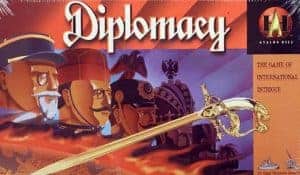 With a reputation for being both complex and the end of many friendships, Diplomacy takes that art of war and adds in something that many board games lack – diplomacy.
With a reputation for being both complex and the end of many friendships, Diplomacy takes that art of war and adds in something that many board games lack – diplomacy.
This is a game about winning a war, of course, but it’s also a game about interpersonal skills. The best players are those who understand that the map is just a starting point and spend time working on how they can work with – and against – their fellow players.
Diplomacy is unique in that it doesn’t have a standard turn order. Instead, players write down their moves secretly and all go at one time. This gives a much more realistic view of war, as there is no ability to patiently wait for your opponent to act. Alliances are formed and fall apart in secret, and almost every game will end with hurt feelings. It is perhaps one of the most beloved war games ever made.
Risk (Parker Brothers, 1959)
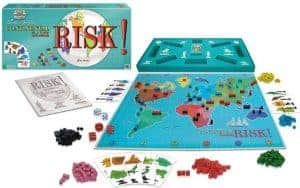
Try my AI Tabletop RPG generators...and an extensive library of content!
Risk presents a view of the world that’s relatively accurate to the Napoleonic era. The world is divided into several territories, with bonuses going to players who control an entire continent. The goal of the game is nothing less than total world domination. Players move armies into new territories to capture them or challenge the players who already hold them. While battles are determined by the luck of the dice, a good player can position their armies in such a way that victory is inevitable.
Rise and Decline of the Third Reich (Avalon Hill, 1974)
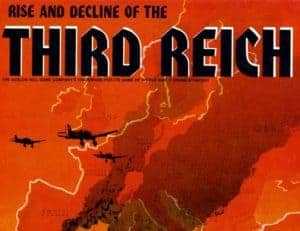
⚔️ Fantasy RPG Random Tables Books
Make life as a Gamemaster easier…
If you play Dungeons & Dragons, Pathfinder, or other fantasy RPGs, this
RPG random tables series
is packed with encounters, NPCs, treasure, and more. Available in eBook or print—either way, you’ll have a wealth of adventure ideas at your fingertips.
The game places players in the roles of the Great Powers on the eve of World War II and players are primed to figure out if the tactics that worked in the real war could play out differently on the table top. Players of countries like Germany are encouraged to try counterfactual strategies, especially if their opponents know how the German army actually operated in the real war. This is a game that requires a great deal of dedication and education, but one that is nonetheless a great simulation of warfare.
I have fond memories of playing this and other Avalon Hill board games with my uncle back in the 1980s. He usually beat me, but I had fun and learned a lot about strategy wargaming. I’d eventually go on to beat my other uncle game after game playing Axis and Allies, but that’s a story for another blog post. We have so many other great games to discuss!
Advanced Squad Leader (1985)
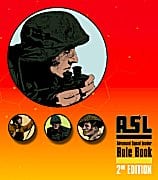
Advanced Squad Leader veers very close to the territory of a miniatures game, but still retains the usual tabletop card stock and victory conditions. There are many official scenarios, but some of the most popular games were made up by players themselves. As the game is relatively easy to adapt, there’s not much a reason for any battle of WWII to go un-played in this game. While you won’t get the grand strategy of some other games, Advanced Squad Leader does provide for a wonderful tactical simulation.
Star Fleet Battles – (Task Force Games, 1978)
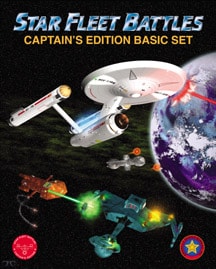
Star Fleet Battles was unique for the way that it handled movement in a war game. Instead of allowing players to take turns, ships would be able to move and act according to their speed. This meant that there would be real tactical advantages to having smaller, faster ships instead of just fleets that could blow anything out of the water. It was an interesting wrinkle in the way that board games worked.
Axis and Allies – (Nova Games, 1981)
Axis and Allies is a game that exists on the general continuum of Risk and Diplomacy. On one hand, the game can be considered quite complex, with a strong economic function required for players to succeed at the game. On the other, victory conditions are relatively simple in most versions – capturing and holding key cities will allow for most scenarios to be brought to a quick end. It’s a fast-paced and fun game, one that’s a good choice for war gamers of a middle skill level.
Axis and Allies has been through quite a few versions, most of which add more cities, more nations, and more win conditions. It’s a well-loved game, one that’s a natural second step for those who get interested in the hobby. While most gamers eventually leave behind Axis and Allies for greener pastures as they get used to more complex rules, this game sees a significant amount of play at most gaming conventions.
Okay, another personal memory. This one involves playing with my younger brother. He would always say, “Bloody battle, bloody battle,” if it involved a lot of units. Good times. Many other fond memories of playing with friends and family over the years. Another memory is from a convention. My uncle and I were playing with a group at a local CON in the Midwest somewhere.
This other guy – whom we didn’t know – pulls out this killer move and retreats his Japanese troops. Our minds were blown! Haha. It wasn’t technically against the rules at that time, and it really allowed the Japanese player to fortify real estate on the Asian mainland. Anyway, so many great memories with this game that I had to share them.
Ambush! – (Victory Games, 1983)
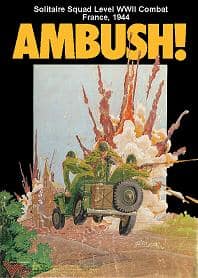
⚔️ Fantasy RPG Random Tables Books
Make life as a Gamemaster easier…
If you play Dungeons & Dragons, Pathfinder, or other fantasy RPGs, this
RPG random tables series
is packed with encounters, NPCs, treasure, and more. Available in eBook or print—either way, you’ll have a wealth of adventure ideas at your fingertips.
Ambush! is not a particularly easy game to customize, so most players stick with the pre-written expansions. In many ways, this game is one that best serves as practice for playing against real people. As soon as you get done with the scenarios, you are done with this game. It’s a bit like playing chess against yourself – useful in the short-term, but not something that’s going to be very helpful against a human opponent.
Wargaming Miniatures
While some war games focus on grand strategy, others are more focused on the combat between individual armies. Instead of using abstract pieces and maps, most of these games use detailed miniatures that fight on small-scale terrain. These are war games in their purest form, often played by individuals who spend countless hours developing both their armies and their strategies.
These games tend to emphasize the ability to understand the battlefield above anything else. Some of the games are incredibly complex, while others are easy enough for children to play. In either case, the games tend to require a great deal of thought from those who choose to enter the battlefield.
Little Wars (H.G. Wells, 1913)
Little Wars has the tremendous honor of being developed by an early science fiction writer. The game itself is incredibly basic, with a few minor rules for deploying toy soldiers and the like. Indeed, it was based off of the rules for shooting down toys. Where the game really shines, though, is in its prose. Written by a true master, it’s a great read even for those who have no interest in toy soldiers.
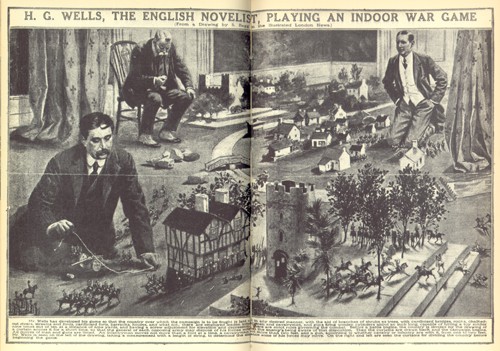
Little Wars is currently available for free, and those who are very interested in the history of war gaming should give it a look. It’s not really a terribly wonderful game and those who have played it tend to tire of it quickly. What’s much easier to enjoy, though, is the book itself. It’s a wonderful look into war and war gaming written by a man who is a master of the English language.
Chainmail (Guidon Games, 1971)
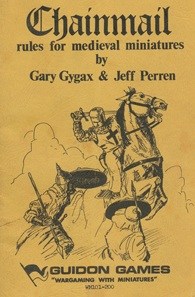
Chainmail tends to be forgotten in war gaming circles, but not because it was a poor game. Instead, it is forgotten because of its true legacy. The Fantasy supplement was so popular that there were eventually rules written down for role playing characters in this setting. In time, those rules would be codified as the first edition of Dungeons and Dragons. As much as some war games owe their existence to D&D, D&D owes its own existence to war games.
Warhammer Fantasy Battle (Games Workshop, 1983)
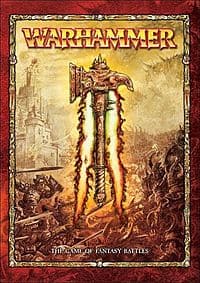
While the background story to Warhammer is interesting enough to have spawned a series of novels, the real fun is in playing the game. Warhammer works on a point system, so players can field armies of truly tremendous size in large games or small squadrons in smaller games. The objective of each game is really up to the players – most are played until one army defeats the other, but it is entirely possible to play an object-based game in this model. Warhammer is always a favorite at gaming stores thanks to the variety of miniatures available.
Try my AI Tabletop RPG generators...and an extensive library of content!
Warhammer 40,000 (Games Workshop, 1987)
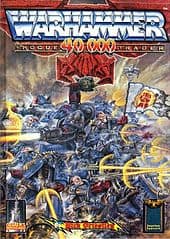
As with the Fantasy version of the game, a huge part of the draw of Warhammer 40k is the variety of miniatures available. It doesn’t cost much to buy a single squadron, but players can spend truly stupendous amounts of money to build up a fully army. With miniatures ranging from individual soldiers to massive dreadnaughts, there’s an amazing number of units available. Combined with an incredibly rich back story, this can turn Warhammer 40k from a small hobby to a major obsession. It’s absolutely one of the war games that any enthusiast should check out.
LegoWars (1991)
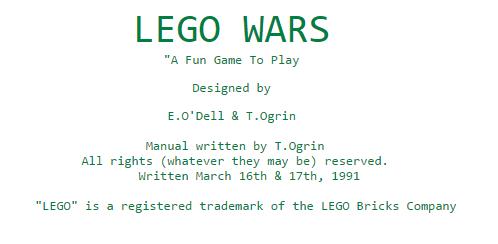
As one might expect, LegoWars was not a licensed product. It was, however, incredibly popular on the internet. It preserved the core experience of war gaming, but took away some of the more expensive and cumbersome aspects of the hobby. When LegoWars was finally hit with a cease and desist order from the Lego company, the game splintered into several different subsets. It was very clear that players wanted this kind of simplified war game, even if the Lego Company didn’t want to be associated with the game.
BrikWars (1995)
BrikWars was the natural successor to LegoWars. Picking up where the former game left off, this game dropped the space theme and instead embraced the weirdness that often comes when children dump out a box of unrelated Lego on the floor. Players could use any themes, figures, and bricks they liked. The rules were made to facilitate play in whatever manner they could.

In terms of mechanics, BrikWars could be both simple and complex. On one hand, movement and actions were easy – a piece could move a certain number of inches, and then take a basic action. Action success and damage are determined by a dice roll.The game gets more complex because of the nature of the figures, though. Figures are given abilities and statistics based on what the figure is holding or wearing at the time. Since the figures can easily be taken apart or destroyed, figures can have very different stats as the game goes on.
Heroscape (Milton Bradley Company, 2004)
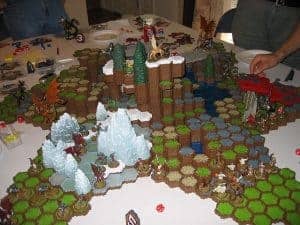
Heroscape also featured a unique rule set. Players could choose to play an “easy” version that was perfect for younger players or an “advanced” version meant for fans of war games. This made it easier to bring children into the hobby and allowed for a casual kind of war game play that wasn’t common at the time. While the game did go out of print in 2010, it does still have many fans. It was a great attempt at bringing war games to the masses.
Computer Wargaming
It should come as no surprise that war games eventually found their way to home computers. PCs allowed players to simulate grander battles and to make use of a far greater degree of detail. These games could do everything that a board or miniature game could do, all without requiring the participation of another player. These games could also raise the stakes significantly.
Computer war games were often electronic versions of board or miniature games. There are, however, a few franchises that are entirely unique to the PC. These games were able to leverage the power of the PC to create truly immersive war simulations.
Panzer General – (Strategic Simulations, Inc., 1994)
Panzer General is one of the best-known war games on the PC, putting players in control of battalion-sized armies during individual battles. The game featured a fairly standard hex-grid map and some very interesting combat concepts, but it was best known for doing what a table top game really couldn’t do.
The individual battles of Panzer General were part of a larger campaign. Whatever happened in one battle would lead into the next scenario. This meant that sacrificing units would matter, and players would be urged to play cautiously so they wouldn’t expend their forces foolishly. It added a supply chain sort of logic to war games that was sadly lacking in many older games. There’s a reason that Panzer General is still so beloved today.
Steel Panthers – (Strategic Simulations, Inc., 1995)
A series of war games on the PC, Steel Panthers put players in charge of incredibly small numbers of units. Players would typically command a single tank or squadron and do their best to accomplish their mission objectives. Players would have a limited number of units in a single game, with some options to accomplish tasks and get more units.
Steel Panthers was a turn-based game really meant to be played against other war gamers. Players could play on the same PC, or they could play by email. The latter feature was novel for the time, but it did help to usher in an era of more connected PC war gaming. While perhaps not as beloved as some other series, this game nonetheless deserves a great deal of praise for pushing PC war games into a more connected future.
⚔️ Fantasy RPG Random Tables Books
Make life as a Gamemaster easier…
If you play Dungeons & Dragons, Pathfinder, or other fantasy RPGs, this
RPG random tables series
is packed with encounters, NPCs, treasure, and more. Available in eBook or print—either way, you’ll have a wealth of adventure ideas at your fingertips.
Close Combat – (Microsoft, 1996)
Close Combat took players back to World War II, this time in charge of a single small platoon or company and had them go through battles in real time. There was no waiting for turns here – players had to deal with things as they came, often making split-second decisions that could impact the outcome of the war. Simply moving into real time made this game stand out from the crowd.
Close Combat also featured a morale mechanic, something that has become very important in newer war games. Players couldn’t just push their soldiers like they were machines. Instead, every victory and loss would have an impact on how soldiers performed. This added a new wrinkle to the genre, one that made players rethink how they used their units.
Future of Wargaming Conflict Situations?
War gaming as a genre is still going strong. While a few titles do tend to dominate the scene in board games, miniatures, and on the PC, there’s still a number of other great games out there. If you have ever wanted to learn how you would fare as a general, these games are as close as you are likely to get. Whether you want something complex or just something that will provide you with a bit of fun, these games will likely give you what you need.
Wargaming for Wargamers?
If you love war games of any variety, be sure to stop by Gaming @ LitRPG Forum to read other great content from people just like you! We’re building a community of geeks using a retro forum and gamification elements. Intrigued? Here’s the Newbie Zone thread. Good luck!

